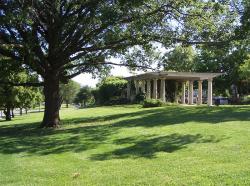
"Who in Europe, or in America for that matter, knows that Kansas City is one of the loveliest cities on earth? [...] the residential section is a masterpiece of city planning [...]; Few cities have been built with so much regard for beauty."
- Andre Maurois, French author and lecturer
Known for blues and barbecue, Kansas City also ranks as one of the most creatively planned cities in the world. Engineer and landscape architect George Kessler leveraged the city's varied topography to design a system of stately parks and boulevards that became a blueprint for the city's growth.
Kessler was an urban planning pioneer who understood how quality design could influence the city's commerce, culture, and social structure. In the absence of effective zoning, he used landscaping to divide residential, commercial, and industrial districts. The plan discouraged congestion, eliminated blighted areas of the city, and sited recreational facilities in walking distance of neighborhoods.
Kessler's plan included some of the first specifications for pavements, gutters, curbs, and walks. Other engineering advances included retaining walls, earth dams, subsurface drains, and an impoundment lake - all part of Kansas City's legacy that has influenced urban planning in cities throughout North America.
Facts
- Kessler's original 1893 plan called for under 10 miles of boulevards and 323 acres of parks. By 1920, the system had grown to 151 miles of constructed and planned thoroughfares and over 3,400 acres of parkland.
- Combining aesthetics with the practicalities of urban planning, Kessler integrated the roles of urban planner and landscape architect. His interconnected design based on the city's natural features was one of the first to serve an entire urban area and continues to be the foundation for Kansas City's growth.
- Kessler carefully considered the city's patterns of commerce and traffic, establishing wide boulevards for carriages, which would be used to maximum effect when carriages were replaced with automobiles.
- The park system encouraged planned land use, raised real estate values, and provided incentives for quality residential developments.
- The city was divided into park districts, each bearing a fair share of the financial burden. An equitable financing plan was key to winning public support.
Resources
- An Historical Survey of the Kansas City, Missouri, Parks and Boulevards System, 1893-1940 , Kansas City Center for Design Education and Research, ISBN 0-9648063-0-4, $24.95, 296 pp, 410 photographs


